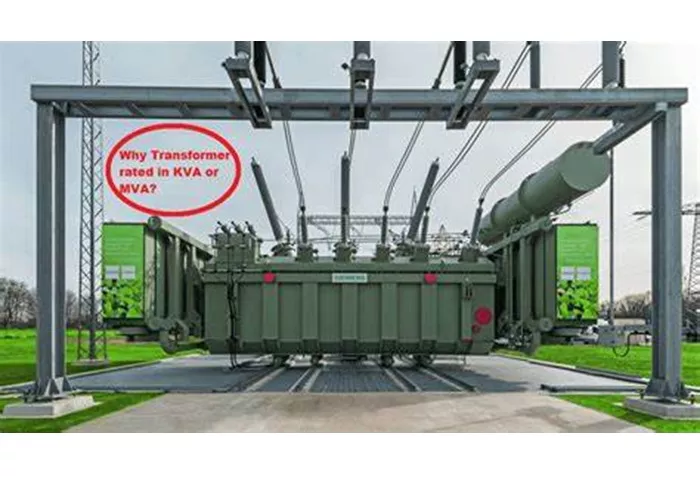Transformers are essential components in electrical systems, designed to efficiently transfer electrical energy between circuits by changing voltage levels. However, they are rated in kilovolt-amperes (kVA) rather than kilowatts (kW). Understanding why transformers are rated in kVA involves exploring the principles of electrical power, the role of power factor, and the practical considerations in transformer design and operation.
Understanding kW (Kilowatt) and kVA (Kilovolt-Ampere)
kW (Kilowatt): Real Power
Kilowatts (kW) represent real power or active power, which is the power that performs actual work in an electrical system. This includes lighting a bulb, running a motor, or any other form of energy conversion. Real power is the portion of electrical power that is used to perform useful work.
kVA (Kilovolt-Ampere): Apparent Power
Kilovolt-amperes (kVA) represent apparent power, which includes both real power and reactive power. Reactive power is the power that builds up in the magnetic fields of inductive and capacitive loads but does not perform actual work. Apparent power is a more comprehensive measure of the total power being supplied in an electrical system.
The Concept of Power Factor
Power Factor: The Ratio of Real to Apparent Power
The power factor is the ratio of real power (kW) to apparent power (kVA). It is a dimensionless number between 0 and 1 and indicates how effectively electrical power is being used. A power factor of 1 (or unity) means all the supplied power is used effectively, while a lower power factor indicates inefficiencies due to reactive power.
Transformers are designed to handle all types of loads—resistive, inductive, and capacitive—which may cause the power factor to vary. The variation in power factor is a critical reason why transformers are rated in kVA instead of kW. Since the power factor can change depending on the load, a transformer rated in kW might not be able to accurately handle varying load conditions.
Why kVA is a More Accurate Transformer Rating
Accounting for Both Real and Reactive Power
Transformers are rated in kVA because it reflects the total electrical demand, including both real and reactive power. Rating transformers in kW would be misleading, as it would only measure the power being used to perform work, neglecting the power consumed by reactive components like inductive or capacitive loads. The kVA rating provides a more accurate representation of a transformer’s capacity to deliver electrical power across a variety of load conditions.
Handling Various Loads and Power Factors
Transformers are often used in systems with fluctuating loads and power factors. kW represents only active power and does not account for reactive power. Rating in kVA ensures that the transformer can handle the combined effects of active and reactive power, making it suitable for a wide range of applications and load conditions.
Transformer Losses: Copper and Iron
Copper Losses and Iron Losses
Transformers incur two main types of losses:
Copper losses: These occur due to the resistance in the transformer’s windings as current flows through them. They are proportional to the square of the current (I²R losses).
Iron losses: Also known as core losses, these occur in the transformer’s core due to hysteresis and eddy currents.
These losses affect the efficiency of a transformer and are included in the kVA rating to ensure the transformer can operate efficiently under load.
Practical Applications and Voltage Transformation
AC Voltage Transformation
Transformers are widely used in power distribution systems to step up or step down voltage levels. Stepping up the voltage reduces current, minimizing energy losses during long-distance transmission. Stepping down the voltage makes it safe for residential and commercial use. These functions are only possible with AC, as transformers rely on the changing magnetic field produced by AC to induce voltage in the secondary coil.
DC Voltage Transformation
For DC applications, different technologies such as DC-DC converters or inverters are used to change voltage levels. These devices convert DC to AC, use a transformer to step up or step down the voltage, and then convert the AC back to DC. This process is necessary because transformers cannot directly transform DC voltages.
The Role of Transformers in Modern Power Systems
Transformers in Power Generation and Distribution
Transformers play a crucial role in modern power systems, enabling efficient transmission and distribution of electrical energy. They are used in power plants to step up the voltage for long-distance transmission and in substations to step down the voltage for local distribution. Without transformers, it would be challenging to manage the high voltages and currents involved in power transmission.
Transformers in Renewable Energy Integration
As the world increasingly relies on renewable energy sources like solar and wind, transformers become even more important. These sources often generate electricity at variable voltage levels, and transformers help regulate and stabilize the voltage for integration into the grid. The ability of transformers to work with AC makes them ideal for managing the fluctuating outputs of renewable energy systems.
Conclusion
In summary, transformers are rated in kVA instead of kW because the kVA rating reflects both real and reactive power, making it a more accurate measure of the transformer’s capacity. By accounting for the power factor and various load types, kVA ensures that transformers can handle the total electrical demand, providing safe, efficient, and reliable power distribution in all kinds of applications. This rating system allows transformers to be versatile and capable of handling different types of loads without requiring recalculations for different power factors.
The kVA rating is not just a technical detail but a fundamental aspect of transformer design and operation. It ensures that transformers can meet the demands of modern electrical systems, providing reliable power distribution and supporting the transition to more sustainable energy sources. By understanding and appreciating the significance of kVA, engineers and technicians can better design, select, and maintain transformers, ensuring optimal performance and efficiency in all applications.
Related Topics:

